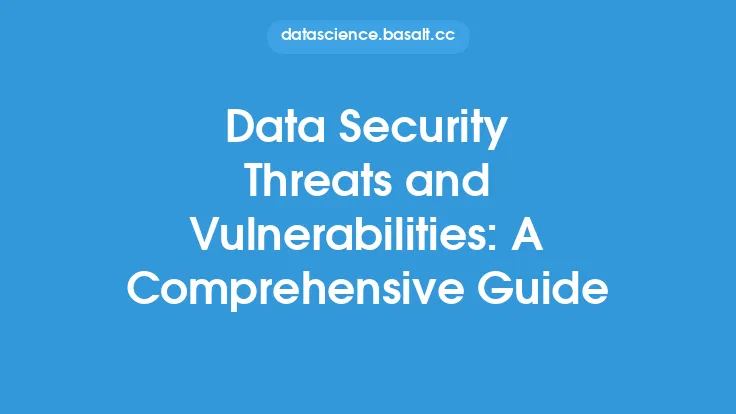In today's digital landscape, network security is a critical component of data protection. As technology advances and the amount of data being transmitted and stored continues to grow, the need for robust network security measures has never been more pressing. Network security refers to the practices, technologies, and policies designed to prevent, detect, and respond to unauthorized access, use, disclosure, disruption, modification, or destruction of computer networks and the data they contain. This comprehensive guide will delve into the world of network security, exploring its importance, key concepts, and best practices for protecting sensitive data.
Introduction to Network Security
Network security is a multifaceted field that encompasses a wide range of techniques and technologies. At its core, network security is about ensuring the confidentiality, integrity, and availability of data as it is transmitted and stored on computer networks. This involves protecting against various types of threats, including malware, viruses, Trojan horses, spyware, adware, and ransomware, as well as unauthorized access and other types of cyberattacks. Effective network security requires a combination of hardware, software, and human factors, including firewalls, intrusion detection systems, encryption, access controls, and user education.
Key Concepts in Network Security
Several key concepts are fundamental to understanding network security. One of the most important is the concept of the CIA triad, which stands for confidentiality, integrity, and availability. Confidentiality refers to the protection of sensitive information from unauthorized access or disclosure. Integrity refers to the accuracy, completeness, and consistency of data, as well as the protection of data from unauthorized modification or deletion. Availability refers to the ability of authorized users to access and use data when needed. Another key concept is the principle of least privilege, which holds that users should only have the level of access necessary to perform their jobs, reducing the risk of unauthorized access or data breaches.
Network Security Threats and Vulnerabilities
Network security threats and vulnerabilities are numerous and varied. Common threats include malware, phishing attacks, denial-of-service (DoS) attacks, and man-in-the-middle (MitM) attacks. Malware, short for malicious software, refers to any type of software designed to harm or exploit a computer system. Phishing attacks involve tricking users into revealing sensitive information, such as passwords or credit card numbers. DoS attacks involve overwhelming a network or system with traffic in order to make it unavailable to users. MitM attacks involve intercepting and altering communication between two parties in order to steal sensitive information or eavesdrop on conversations. Vulnerabilities, on the other hand, refer to weaknesses in software, hardware, or configurations that can be exploited by attackers.
Network Security Measures and Technologies
A wide range of network security measures and technologies are available to protect against threats and vulnerabilities. Firewalls, for example, are network security systems that monitor and control incoming and outgoing network traffic based on predetermined security rules. Intrusion detection systems (IDS) and intrusion prevention systems (IPS) monitor network traffic for signs of unauthorized access or malicious activity. Encryption technologies, such as SSL/TLS and IPsec, protect data in transit by converting it into an unreadable format. Access controls, including authentication, authorization, and accounting (AAA) protocols, ensure that only authorized users have access to sensitive data and systems.
Best Practices for Network Security
Best practices for network security are essential for protecting sensitive data and preventing cyberattacks. One of the most important best practices is to implement a defense-in-depth approach, which involves layering multiple security controls and technologies to provide comprehensive protection. Regular software updates and patches are also critical, as they help to fix vulnerabilities and prevent exploitation. Network segmentation, which involves dividing a network into smaller, isolated segments, can help to limit the spread of malware and unauthorized access. User education and awareness are also essential, as they can help to prevent phishing attacks and other types of social engineering.
Network Security Frameworks and Standards
Network security frameworks and standards provide a structured approach to implementing and managing network security. The NIST Cybersecurity Framework, for example, provides a comprehensive framework for managing and reducing cybersecurity risk. The ISO 27001 standard provides a set of requirements for implementing and maintaining an information security management system (ISMS). The PCI DSS standard provides a set of requirements for protecting sensitive payment card information. Compliance with these frameworks and standards can help organizations to ensure the security and integrity of their networks and data.
Conclusion
In conclusion, network security is a critical component of data protection in today's digital landscape. By understanding the importance of network security, key concepts, threats and vulnerabilities, measures and technologies, best practices, and frameworks and standards, organizations can help to protect their sensitive data and prevent cyberattacks. Effective network security requires a combination of hardware, software, and human factors, as well as a comprehensive and layered approach to security. By prioritizing network security, organizations can help to ensure the confidentiality, integrity, and availability of their data, and protect themselves against the ever-evolving threats of the digital age.





